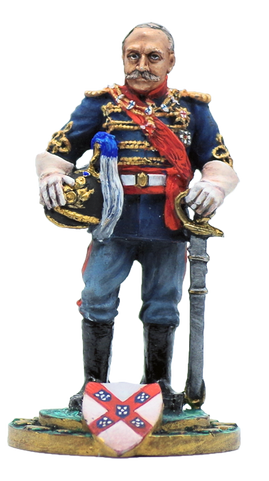
Prince Miguel
Duke of Braganza
Prince Miguel Januário of Braganza (Portuguese full name Miguel Maria Carlos Egídio Constantino Gabriel Rafael Gonzaga Francisco de Paula e de Assis Januário de Bragança; 19 September 1853 – 11 October 1927) was the Miguelist claimant to the throne of Portugal from 1866 to 1920. He used the title Duke of Braganza. Miguel Januário was born in Castle Kleinheubach, near Miltenberg, Kingdom of Bavaria, on 19 September 1853 during the exile in Germany of his father, former King Miguel I of Portugal and the Algarves. His mother was Princess Adelaide of Löwenstein. He was a grandson of King John VI of Portugal, Brazil and the Algarves and his wife, Queen Carlota Joaquina. By the Portuguese law of banishment of 1834 and the constitution of 1838, King Miguel was forbidden to enter Portugal. Therefore, he was educated in the German Confederation and in Austria-Hungary.


Guarda Municipal. The Royal Guard of the Police of Lisbon was created in 1801 by Prince Regent D. João, on the proposal of the General Intendant of the Police of the Court and the Kingdom, Pina Manique, following the model of the French Gendarmerie, which had been created in 1791. Note that, as early as 1793, Intendant Pina Manique had organized, on an experimental basis, a military police company, a predecessor of the GRP. Following the GRP of Lisbon, the Porto Royal Police Guard and the Military Division of the Royal Police Guard were created, the latter being the origin of the Municipal Guard of Rio de Janeiro and of this, the current Military Police of the State of Rio de Janeiro and Military Police of the Federal District, in Brazil. According to the regulations, the Guard should be "formed by the best soldiers, chosen from across the Army, not only among the most robust, firm, single, and up to 30 years of age... but also of good temperament and conduct", until because «His Majesty wants the Corps of the G. R. P. to be a National Force, which will ensure the internal tranquility of the Capital», and its members should «consider their admission to this Corps as a principle of remuneration that His Majesty gives for his services previous ones.” It was, therefore, considered an elite corps. The Guard carried out its police functions in the city of Lisbon and its surroundings with competence and good results. At the end of 1807, with the departure of the royal family and
the court to Brazil, due to the first French invasion, he remained in service, not having embarked. With the end of the French occupation, the Guard resumed its normal activity, with the major of cavalry regiment no. 9, from Chaves, Filipe de Sousa Canavarro, being appointed its commander, with the rank of colonel. At the end of May 1834, King D. Pedro IV, assuming the regency in the name of his daughter D. Maria II, and due to the fact that the Royal Guard of the Lisbon Police, right at the beginning of the conflict that led to the civil war, if placed alongside D. Miguel, it extinguishes the GRP of Lisbon and Porto. Creating the Lisbon Municipal Guard and the Porto Municipal Guard, with identical characteristics. In 1868, both Guards were placed under a unified General Command, installed in the Carmo Barracks, in Largo do Carmo, in Chiado, Lisbon, which is still the GNR Headquarters today. The Municipal Guard was considered part of the Portuguese Army, but was dependent on the Ministry of the Kingdom for all matters relating to Public Security.

The title Duke of Braganza (Portuguese: Duque de Bragança) in the House of Braganza is one of the most important titles in the peerage of Portugal. Starting in 1640, when the House of Braganza acceded to the throne of Portugal, the male heir of the Portuguese Crown were known as Duke of Braganza, along with their style Prince of Beira or (from 1645 to 1816) Prince of Brazil. The Most Serene House of Braganza (Portuguese: Sereníssima Casa de Bragança), also known as the Brigantine dynasty (dinastia Brigantina), is a dynasty of emperors, kings, princes, and dukes of Portuguese origin which reigned in Europe and the Americas. The house was founded by Afonso I, 1st Duke of Braganza, illegitimate son of King John I of Portugal of the House of Aviz, and would eventually grow into one of the wealthiest and most powerful noble houses of Iberia during the Renaissance period. The Braganzas came to rule the Kingdom of Portugal and the Algarves after successfully deposing the Philippine Dynasty in the Restoration War, resulting in the Duke of Braganza becoming King John IV of Portugal, in 1640. The
Braganzas ruled Portugal and the Portuguese Empire from 1640 and with the creation of the United Kingdom of Portugal, Brazil and the Algarves, in 1815, and the subsequent independence of the Empire of Brazil, in 1822, the Braganzas came to rule as the monarchs of Brazil. In the history of Portugal, a Miguelist (Portuguese: Miguelista) was a supporter of the legitimacy of the king Miguel I of Portugal. The name is also given to those who supported absolutism as form of government, in opposition to the liberals who intended the establishment of a constitutional regime in Portugal. King Miguel I was exiled following the Convention of Evora-Monte (1834), which put an end to the Liberal Wars. The throne was retaken by his niece, Queen Maria II, and a liberal regime was installed. In exile, the former king married a wealthy Bavarian princess, Adelaide of Löwenstein-Wertheim-Rosenberg. This marriage was the origin of the new Miguelist branch of the Braganzas and their descendants include not only the current claimant to the Portuguese crown, as well as the monarchs of Belgium, Luxembourg, Liechtenstein, and other claimants to former European monarchies (Habsburg, Habsburg-Este, Savoy, Wittelsbach, Bourbon-Parma, Mecklenburg-Strelitz, Karadordevic).
Awards: Collar and star of the Royal Equestrian and Military Order of Saint Michael of the Wing, Insignia of the Distinguished Order of the Golden Fleece, Star of the Royal Order of Saint Hubert (Bavaria).






